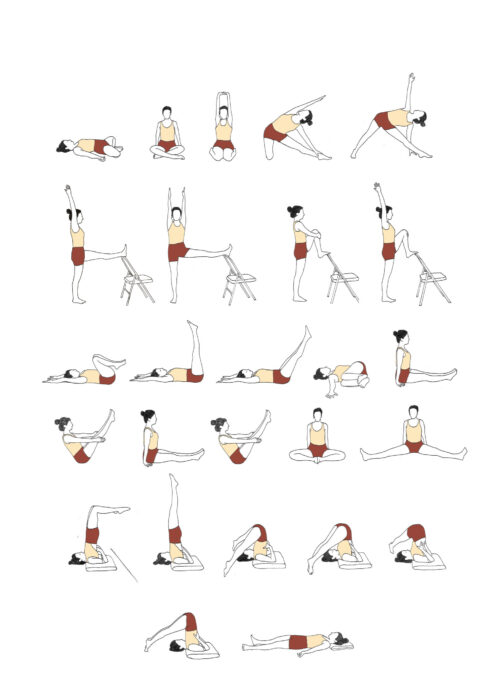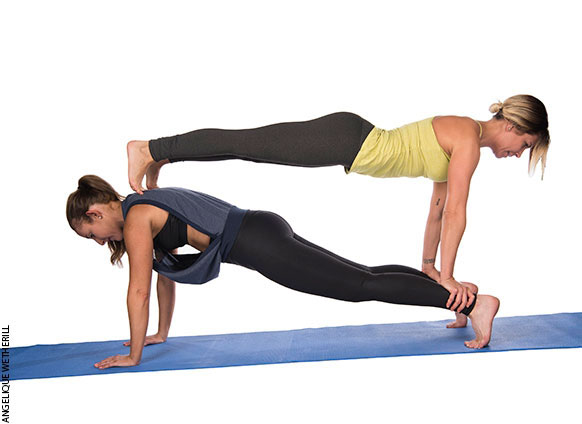
A good routine for morning yoga can help you get through the day quickly and efficiently. You can do yoga wherever you find time. A 10-minute routine will help you relax, wake-up, and feel more positive. This is a great way of starting your day. Here's a basic sequence of poses for beginners. These pose targets different areas of the body and provide specific benefits. For the most immediate benefits, practice these first thing in the morning.
This session only takes ten minutes. The session will leave you feeling calmer and more energetic. The routine can consist of three or five poses. Each pose can have a different goal. You should try different variations to see which one works for you. You can also vary the stretches, and you can change the poses to reach your goals. These are some basic stretches that beginners can do:
Firefly Pose (or Firefly Pose): This is an easy yoga pose that will help you stretch your arms, hips, and hamstrings. You will need to place your hands inside of your legs while you are seated on the floor. Place your hands in your legs and lift your gaze. Your arms should touch your upper thigh. Keep your center point of gravity low and your legs straight. This will help you stretch more evenly.

Child's pose: This pose is great to start with because it allows you connect to your breath as well as stretching your lower back. This position can be done on all fours. Spread your knees wide to allow your big feet to touch. Your forehead should be towards the floor. Now, lower your head and drop to the floor. Keep this going for 10 minutes, until you feel more flexible. If you're too busy to do it in the morning, set an alarm for 10 minutes so you can squeeze it in.
Standing up, bend your left knee. Your left foot should be pointing towards your glutes. Use your left hand to grasp the inner arch of your left foot and lift your left leg toward the ceiling. Reach forward with both your arms and watch your breath. Keep going for at least ten minutes. The sequence should not be difficult. It will take you 10 minutes to do a morning yoga routine. This will allow you to get started with your yoga practice, and it will also help keep your body relaxed.
Yoga can be done anywhere by beginners. Yoga should be practiced in a quiet area, away from any distractions, to get the best results. Choose poses that you feel comfortable with. If you are uncomfortable with any of the poses, music can help you get the best results. To help you relax and get into the poses, play calming music. A 10 minute session of morning yoga can help you get rid of old habits, and set the stage for a happier day.
Russian twists are an excellent core exercise. You can do them with your feet on the mat or with your heels lifted. Russian twists are best done seated. To start this pose, stand on your tiptoes and extend your right leg behind your back. Then, bend your right knee and reach your hands over your head. The Cat-Cow pose is a great way to strengthen your back and legs.

During this pose, the right knee should be over the left ankle. The left leg should be in front of the right foot. The right arm should reach forward and the left should be extended back. The left leg must be bent over the right heel. The right knee should rest on the left knee. In this way, the right leg is bent over the left, while the left foot is bent over the front.
Plank: Start on your stomach with bent knees. Flat feet. Your palms should be facing down so that your hands are on your sides. To stretch your shoulders and hamstrings, you can try the cat pose. Next, move on to the cow pose to loosen your hips. To complete the sequence, you can perform the cat, seated twist, or the cactus poses.
FAQ
Is cardio exercise good for your health or bad?
Cardiovascular exercise has many advantages. Cardiovascular exercise improves blood circulation and strengthens your heart muscle. It also increases stamina and helps you lose weight.
Cardiovascular exercise includes running, biking, hiking, swimming, tennis, basketball, soccer, volleyball, football, etc.
It is important that cardio exercises are not performed at high intensities. This could cause injury.
The cardiovascular exercise should only be performed if you feel good.
Do not push yourself to the limit. This could lead to injury.
Cardiovascular exercise is best done warm-up first. Gradually increase the intensity.
Remember, you should always listen to your body. If you feel pain during cardiovascular exercise, stop immediately.
Also, after a cardiovascular workout, it's advisable to take a rest. This will give your muscles time for recovery.
Cardiovascular exercise is essential for losing weight.
It is the most efficient way to lose weight and stomach fat.
What is the best way to increase muscle mass?
There are two major exercises that you should do when you want to build muscle mass. These include isolation exercises and compound movements. Isolation exercises target specific muscles while compound moves focus on multiple groups at once.
Your best option to improve your fitness is to work out with exercises that challenge all your major muscle group. This will ensure that you work hard every session.
An app called MyFitnessPal allows you to keep track of everything. You can log everything, from calories burned to weight lifting. You can also create customized meal plans based upon your goals.
Eggs good for men
The egg contains all the nutrients required by the human body. It helps to maintain strong bones and healthy hearts and lungs and stabilize blood pressure.
Eggs are rich in protein, vitamin A, B12 and D,E,K, as well as vitamins A,B12 and D,E,K, calcium, iron, phosphorus, manganese, copper, magnesium, and riboflavin.
The egg yolk has high cholesterol. The egg yolk does not contain saturated oil. Eggs are lower in saturated fat than other foods.
They are also low-calorie and high in sodium. They are also very versatile because you can cook them any way you want. You can fry, poach, scramble, boil, hard-boil, and bake them.
They are very nutritious and easy-to-prepare.
You should eat at least two whole eggs per day. You can add eggs to your diet if you don't like eating eggs.
Eggs provide essential nutrients needed by our bodies. Consider adding eggs to your daily meal plan today.
How many calories do I need to eat each day?
This will vary from person-to-person. The average is 2000 - 2500 calories per day. It's important to assess your life style, gender, age and height in order to determine how much calories you need.
Statistics
- According to the American Heart Association, blood pressure should be checked at least once every two years, beginning at age 20. (my.clevelandclinic.org)
- 10 pounds in a month is likely during a lean bulking phase, especially for beginners. (muscleandstrength.com)
- According to the American Academy of Dermatology (AAD), men over 50 are at a heightened risk of developing it. (healthline.com)
- The PRS enabled risk stratification for overall prostate cancer and lethal disease with a four-fold difference between men in the highest and lowest quartiles (HR, 4.32; 95% confidence interval [CI], 3.16-5.89). (pubmed.ncbi.nlm.nih.gov)
- By John Thompson Take a whopping 38% off a set of PowerBlock Pros. (menshealth.com)
External Links
How To
How do I lose weight while working out?
Exercise helps you lose calories by increasing your metabolism and oxygen intake.
If you exercise with moderate intensity, you can safely lose weight.
These are some tips to help you lose fat while working out:
-
Cardio exercises can include running, walking, swimming or cycling.
-
Do 30 minutes of exercise three times a week.
-
Strength training is a great way to lose weight.
-
Avoid doing intense exercises. It's possible to build muscle, but not lose it.
-
Drink plenty of water during exercise. Water helps to flush out toxins from the body and maintains proper hydration.
-
After exercising, you should drink low-fat protein drinks. Protein shakes boost energy and repair muscle tissue.
-
Eat smaller meals throughout the day, so you don't feel hungry between meals.
-
Don't skip breakfast! Skipping breakfast can leave you feeling tired and sluggish.
-
Take care of yourself mentally. Stressful situations can affect your metabolism.
-
Keep a positive attitude. Studies show that people who believe they are overweight gain more weight then those who think they are attractive.
-
Get enough sleep. A lack of sleep makes it difficult to lose fat.
-
Always be active. Be sure to get up and move around every hour or two.
-
Maintain a healthy diet. Eat right to feel satisfied and full for longer.
-
Find ways to relax. A tense mind doesn't allow your body to release stress hormones that break down muscle tissue.
A balanced diet is one that includes all of the essential nutrients required for growth.
Instead of eating three large meals a day, eat six smaller meals every day. This gives your body time and energy to process the food.
To maintain strong bones, you need to consume 500 mg of calcium each day. Calcium can be found as a dairy product such as milk, yogurt and fortified soy drinks, orange juices, cereals, breads, and cereals.
Calcium is found in leafy vegetables, beans and tofu, as well nuts, seeds and cheese.
Vitamin D is essential for calcium absorption. Vitamin D can be found in egg yolk, fatty fish, and other fortified foods.
Vitamin E is vital for your skin's health. Vitamin E can be found in vegetable oils as well as wheat germ oil, peanuts and almonds.
Your body needs zinc to maintain normal immune function and heal wounds. Zinc is found in seafood, oysters legumes meats, whole grains, whole grains and meats.
Zinc deficiency can cause fatigue, loss of appetite, depression, and impaired immunity.
Insulin resistance is caused by eating too much sugar, which can increase blood glucose levels. Insulin resistance can lead to weight gain.
Insulin resistance is caused by high blood levels of free-radicals. Free radicals can be molecules with unpaired electrons that cause damage to cell membranes.
Free radicals come mainly from food additives, pesticides, herbicides, preservatives, smoking, air pollution, radiation, chemicals in cosmetics, lotions, and household cleaning supplies.
Free radical damage can lead to cancer, heart disease, diabetes, arthritis, asthma, and aging.
The best way to avoid free radicals is to eat a balanced diet high in antioxidants. Antioxidants protect against oxidative damage.
Vitamin C is found in citrus fruits and beta carotene is found in carrots.
Selenium, copper and manganese are all antioxidant nutrients.
Selenium is known to protect cells from the oxidative damage that free radicals can cause. Selenium is found in Brazil nuts, tuna, liver, kidney, shrimp, cod, turkey, beef, lamb, pork, and chicken.
Copper protects eyes, brain, lungs and red cells. Copper is also found in poultry, meat, and organs.
Manganese forms an essential part of bone structure. Manganese may be found in brown rice or spinach, bananas and prunes as well raisins, oatmeal and lentils.
Zinc is important for healthy growth, reproduction, and wound-healing. Zn is present in lean cuts of meat and white fish, as well as eggs.